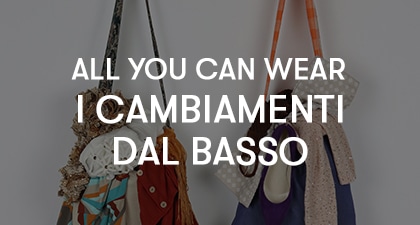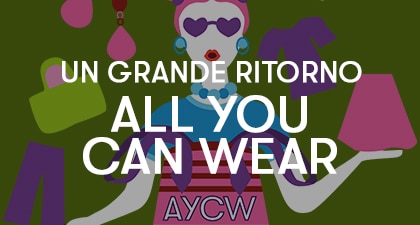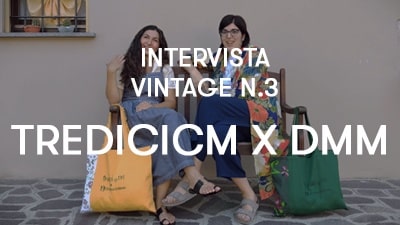
In the second episode of the series “Vintage Interviews“, the lights in the room go down and the spotlight shines on a digital creator, Serena Autorino, who has turned her passion for vintage into a full-time job, creating content on her platforms and offering consulting for brands and stores.
But she will explain this better in the following questions. We just want to briefly highlight how impressed we were by her expertise in this field, which goes beyond just a deep knowledge of the history of fashion and vintage stores. It also touches on topics like sustainability, the social meanings of clothing, the evolution of vintage in the near future, and the awareness of how all of this will influence the developments of fashion in the years to come.
So, let’s begin!

Hi Serena, you’ve been working for years on many things, including vintage clothing (you even wrote a master’s thesis on it and are currently pursuing a PhD on the topic). How did your interest in this subject develop?
When I was little, I enjoyed “searching” through the wardrobes at home. I didn’t know it was vintage; for me, it was just a way to dress originally. Then I studied fashion and communication, and I became fascinated by the nostalgic component. I understood it, I explored it, and I made vintage my main interest, not only in fashion but also as a language, a filter of the world. Today, vintage is not just the clothing from thirty years ago that we buy; it’s much more: it’s a category of goods, but also a world of inspirations, of content to be reworked, in every field.
What would you say to someone who told you that clothes are frivolous, and that art is something different from fashion?
I’d say they really don’t know much about what fashion has always represented. I’m a teacher of a course on vintage styling and fashion history (at Italian Image Institute) and one of the things I care most about, while illustrating the different decades, is showing students how clothing has always been a mirror of society. People adapted it to practical needs (for example, during wars, women wore practical clothing to replace men at work), used it to rebel, and expressed their ideals (such as during the ’20s and ’60s). Clothes are never just clothes.
What does dressing mean for you, Serena?
It means expressing oneself. I’ve always thought of it this way; as a child, I always wanted to stand out. Paradoxically, perhaps because I’m shy (at first), so I want my clothes to speak for me and express my entire personality. Dressing is also the most fun game we can all play: every day, by simply opening our wardrobe, we can decide who we want to be, what we want to communicate. Whoever opens my wardrobe might have trouble identifying a single style because the most beautiful thing for me is constantly changing.
Which decade in the history of 20th-century fashion is your favorite and why? Or do you have any style icons that particularly inspire you?
From the fashion history perspective, definitely the 1960s. It’s a truly fascinating decade full of change: items like the miniskirt symbolized revolution, there are many connections to music, and fashion became for everyone… However, what I personally wear the most are the 1980s/1990s, the ones I’m most familiar with because I found them in my mom’s wardrobe, so I still look for them when shopping. Some of my style icons from the past are Twiggy, Katherine Hepburn, Bianca Jagger but also more “recent” ones like Julia Roberts, Meg Ryan, Sarah Jessica Parker. I like to find inspiration in movies and TV shows, but also from contemporary figures who combine vintage in a modern and original way (like Leandra Medine).

We had fun creating some outfits for this interview. Of course, since you chose them, they probably all represent you in some way. But which piece stood out to you the most, and why?
Among the pieces selected, my favorite is definitely the brown dress from Gai Mattiolo. It’s a classic ’90s piece in its lines but made unique by its color, which not everyone would choose. Every item has a “common” story, which everyone can recognize, as it belongs to a specific period, maybe it’s similar to a famous outfit from a movie… but the reasons that attract us to it are very personal. For example, this one reminds me of many of my mom’s dresses because she loves this color and it looks great on her (we’re practically identical, so seeing myself in things like this feels like flipping through a family album).
We first met at Vestiaria Summer and you seemed really enthusiastic about the store… Could you tell us a bit about what impressed you about our Espinasse location?
I find Di Mano In Mano to be a truly well-made project, unique in its kind. Not only for the fashion aspect, but also for the furniture and all other sectors such as books and vinyl… I really like the idea of social commitment and the fact that there is great attention to the selection, always made with taste, and to the prices, never excessive… In fact, there are many great deals. The store in Espinasse is truly enchanting, also in terms of space, thanks to its light and high ceiling; it’s a pleasure to get lost shopping.
You recently wrote a book, “Grazie, è vintage“. In relation to the themes it addresses, who would you recommend it to?
The book is intended to be especially helpful for those who want to approach the world of vintage and want to better understand it, both from a practical purchase perspective and from a historical and semantic one. Many people in the sector have told me that it offers interesting insights and useful tidbits even for those who are already “experts”. So, I would say it is suitable for anyone who already loves vintage and for those who want to fall in love with it.

What do you consider to be your greatest professional achievement?
Surely the publication of the book was a dream come true. Every time someone writes to tell me they’re reading it or that they liked it, it’s a great satisfaction. A more personal achievement, related to vintage, is also the scholarship for the PhD I am pursuing, on the theme “The opportunities of vintage for companies: from the enhancement of heritage to circularity and upcycling, with the goal of more sustainable fashion.”
Do you have any other vintage-related projects or activities at the moment?
Let’s say I do a lot of things, even outside the world of vintage. Right now, the ongoing projects are: the PhD, my social media work creating content and spreading knowledge, the course I mentioned, consulting for brands, shops, and digital projects related to vintage.
We are not in a job interview, but… where do you see yourself in five years?
I definitely hope to do more and more consulting and be recognized as a professional and expert in the field. My work is heading in that direction.
And what about the world of vintage? In what direction do you see it going and how do you think it will evolve, say, in ten years?
Surely the growing interest in vintage has its pros and cons. It’s great that so many people are passionate about it, but unfortunately, this has also led to some improvisation from sellers who are not necessarily experts and just want to ride the wave. Another logical consequence is that, sooner or later, vintage will run out and therefore become a more valuable commodity. What I hope is that the future of vintage will be more understood and more selective, and I hope a vintage culture will develop to make consumers more aware of what they are purchasing.

What we can infer is that vintage will increasingly be present in other forms, such as recycling or upcycling… New ways of dressing and creating more sustainable fashion, and it will be more modern and digital, thanks to the new generations.
Thank you so much, Serena, for your words and all the reflections you’ve shared with us. We look forward to seeing you soon in our stores and take the opportunity to remind our readers that for a few more days, there are Sales with 50% off on the clothing section only at our stores in Milan and Cambiago. Also, products listed on our online store will be discounted by half if purchased in-store. We look forward to seeing you!







